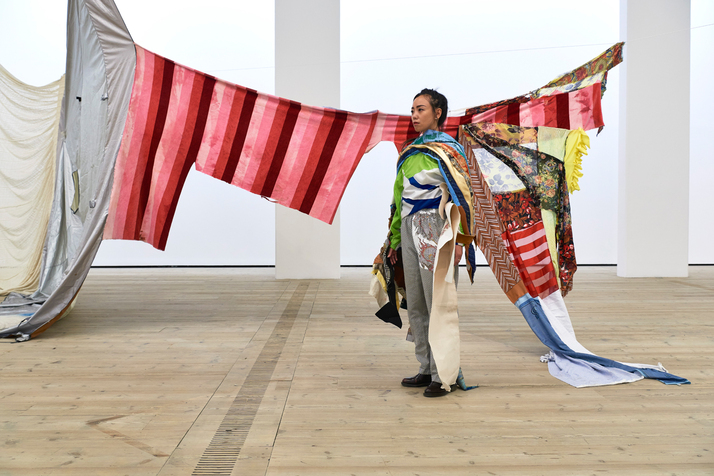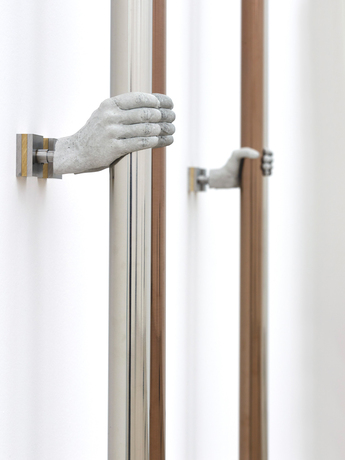-
From Current Issue
-
- Editor’s Letter Fire in the Heart
- Reviews I Gusti Ayu Kadek Murniasih
- Reviews 11th Seoul Mediacity Biennale: “One Escape at a Time”
- Dispatch Networked China
- One on One Monira Al Qadiri on Yukio Mishima
- Essays The rise of independent art spaces in pandemic-era Shanghai
- Features Tuan Andrew Nguyen
- Table of Contents
- Web Exclusives
- Archive
- Subscribe

R
E
V N
E
X
T
SHEN XIN, Provocation of the Nightingale, 2017, four-channel video installation, dimensions variable. Installation view at the Baltic Centre for Contemporary Art, Gateshead, 2017. Courtesy the artist and the Baltic Centre for Contemporary Art.
The newly created Baltic Artists’ Award, organized by Gateshead’s Baltic Centre for Contemporary Art, provides winners with £25,000 (USD 33,000) to create new work for a 13-week exhibition at the centre, and a £5,000 (USD 6,500) fee. This year’s winners, selected by artists Monica Bonvicini, Mike Nelson, Pedro Cabrita Reis and Lorna Simpson all dealt in a kind of deconstruction, reducing objects and concepts to their constituent parts and presenting them anew, so that each fragment might be looked at from different perspectives.
Mexican artist José Dávila referenced Gateshead’s urban-industrial past and elements visible in cities internationally, with a site-specific installation in which girders, large stones, and a playfully placed red balloon are suspended in the air like an abstracted, minimal cityscape; New York-based Eric N. Mack pulled apart the concept of painting with his collages of often domestic objects; and Toni Schmale’s sculptures took the appearance of parts from dismantled machines, which explore how bodies interact with their environments through resemblances to torturous gym equipment and factory apparatus.
Perhaps the most complex example of this gesture of deconstruction was to be found in Chinese-born, London-based artist Shen Xin’s Provocation of the Nightingale (2017). The four-channel installation is projected onto the walls of an exploded cube around and through which visitors can move. On the outside of one wall, a projection depicts a conversation between the manager of a DNA testing company and her meditation teacher, both of whom are immigrants to Korea. They sit on a black stage, and begin with the teacher lightly admonishing the student over the nature of her profession. It isn’t long, however, before the tables are turned, and the student begins to ask her teacher why she charges so much for her classes. As the conversation brushes on disparate themes including issues surrounding DNA testing and identity, the interlocutors’ hands brush on each other’s bodies, exposing a romantic subtext to the encounter that culminates in the student leaning forward to kiss the teacher, who flinches as the film cuts to black.
Shen’s installation eschews narrative, both as a whole and in its constituent parts. However, as each channel begins and another ends, ineffable connections begin to appear. Screened on the outside of the cube’s opposing wall, another projection shows slowly panning footage of an empty auditorium while a backing track plays interview fragments conducted by the artist with people who have taken DNA tests themselves. Some recount discoveries of previously unknown ancestry, and others, revelations of susceptibility to disease. The mediation teacher’s ethical critique of DNA testing and its potential for exploitation rings true in the agitated voices of some speakers, as does the apparent inadequacy of forming identity around a single trait. One woman’s statement that “this is 100% what a Native American looks like,” is ironically accompanied by a shot of many empty seats.
Between the four walls, two further channels are displayed simultaneously. One shows a television set mounted on a stage in the same empty auditorium. Fragments of documentaries play on the TV screen—histories of Korean “comfort women” subjected to sexual slavery by the Japanese military during the Second World War, and reports of Muslim minorities in China—although with incomplete soundtracks, leaving only footage mediated by editing, screens and the stage. Meanwhile, from the opposing channel come sounds suggestive of violent struggle—grunting and heavy footsteps. This second projection, however, shows no struggle. Rather, we see a man and woman, on a stage again, sweating and breathing heavily. The camera pans occasionally to the woman’s feet. A bending knee or pivoting ankle suggests a step forward toward reconciliation or a further brawl, but the two remain ultimately frozen.
Shen’s work is not easy to decode, and with so much material it risks appearing cluttered. However, the way she distributes her images through a fragmented space allows novel perspectives on phenomena we often consider from only one—our own—angle, such as history, consciousness, romance, religion and sex. The artist provides no answers but, as might be said of her fellow winners, she deconstructs the world in such a way that we might walk between its parts, putting them together in order to find our own.
Work by the winners of the inaugural Baltic Artists’ Award will be on show at the Baltic Centre for Contemporary Art, Gateshead, until October 1, 2017.
To read more of ArtAsiaPacific’s articles, visit our Digital Library.







